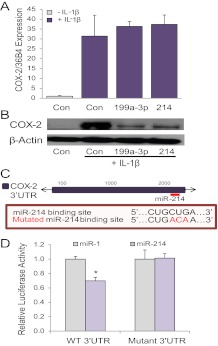Fig. 2.
miR-199a–3p and miR-214 target COX-2 expression at the level of protein translation, rather than mRNA stability. Like miR-199a–3p, miR-214 targets COX-2. A and B, Overexpression of miR-199a–3p or miR-214 in human immortalized myometrial cells (hTERT-HM) cultured ± IL-1β for 24 h had no effect on COX-2 mRNA expression (A) but markedly decreased COX-2 protein levels (B). COX-2 mRNA expression was analyzed by qRT-PCR and normalized to h36B4. Data shown in A are expressed relative to hTERT-HM cells transfected with a scrambled control miR (Con) and cultured in the absence of IL-1β, which were assigned a value of 1. C, Schematic of the location of the putative miR-214 binding site in the 3′UTR of COX-2. Sequence of the putative miR-214 binding element and of the mutated binding element also are shown. D, Luciferase activity of COS-7 cells cotransfected with the recombinant pMIR-REPORT plasmid containing the WT COX-2 3′UTR subcloned downstream of luciferase was decreased when cotransfected with mimics for miR-214, compared with cells cotransfected with miR-1 (used as a negative control and assigned a value of 1). This repression was lost when the putative miR-214 binding site was mutated (n = 3 per group). Values shown in all bar graphs are the mean ± sem. *, P < 0.05. Immunoblots are representative of findings from three independent experiments.

